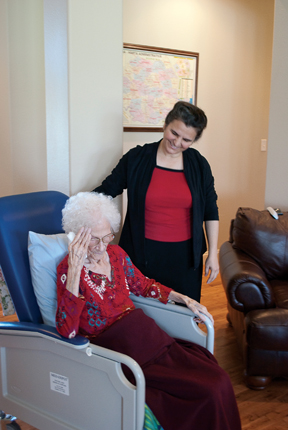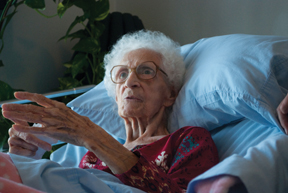Story By Cody Winchester
Photos By Denton Ramsey
Nina Ferguson, 91, is resting in a hospital bed in her room in the home she shares with her friend and caregiver, Lucy Lupu. Nina is slender and frail – Lucy estimates her carrying weight at 95 pounds – but her eyes are bright and clear, and she thumps her chest defiantly when Lucy suggests she could be eating better. Lucy is talking about how, in early February of last year, Nina almost died. She had been staying in a local nursing home when she developed a sore on her foot. She said the staff didn’t change the dressing for two weeks, and infection set in.
Her decline was rapid. A doctor recommended discharge and home hospice care; Nina’s diagnosis was “adult failure to thrive/debility,” one of nine noncancer terminal diagnoses recognized by all Medicare-certified hospices. This meant, according to the doctor, that she had less than six months to live.
Nina has been on hospice care for more than a year and a half now. Five months after her ordeal at the nursing home, she moved in with Lucy, who built her spacious brick home outside Axtell with patients like Nina in mind. All the supplies Lucy needs to care for Nina – diapers, pain medication, an oxygen machine, her bed – are supplied by Providence Hospice, one of eight Waco-based hospices and one of two that operate on a not-for-profit basis. Additionally, a hospice nurse visits Nina once or twice a week.
“It’s a blessing,” Lucy said. “Without them I don’t know how we’d do it.”

The philosophy behind hospice care is often summed up as “care, not cure.” Teams of nurses, chaplains, social workers and volunteers work with terminal patients to maintain quality of life, providing things like pain medication, speech therapy, dietary counseling, help with housework, caretaker relief and, after the patient dies, bereavement counseling for family members.
“Having people surround you, being in a caring environment, being at home – but still having professional care? That’s a good death,” says Dr. Lacey Gillentine, who teaches a popular class on death and dying at Baylor University.
The idea of hospice care, which dates to midcentury England, represents a cultural shift in our expectations about dying, Gillentine says. It used to be that you died at home, with your family, and people were more apt to view death as a natural extension of life. Advances in medical technology meant that more dying people went to the hospital, where death is hidden, remote, “cleansed of its organic blight,” as Sherwin Nuland, author of How We Die, puts it. Hospice offers patients and their families a greater measure of control, as well as a more holistic approach that helps mitigate the loneliness and anomie of death.
“I think now we’re just trying to get back to those roots, and trying to get back a little of that comfort and control we once had,” Gillentine says.
Despite this, more people still die in a hospital or nursing home than die in hospice or home care. And America is graying: The population aged 65 and over is increasing at a faster rate than the population as a whole. The Census Bureau predicts that a fifth of the Texas population will be over age 60 by 2030.
Hospices generally treat terminal patients of every age, but the majority are “natural” end-of-life cases (Providence puts its average patient age in the mid-70s). While the official cause of death may be cancer or heart disease or pulmonary infection, with elderly people these are often merely proximate causes. In the end, our bodies simply wear out.
***
Providence is an affiliate of Community Hospice of Texas, the state’s largest hospice network, which sees patients in a 60-mile radius of Waco. In 15 years of doing business, they’ve seen their average monthly patient census jump from around 90 to 231 in August. The average stay is 75 days. They treat mostly home-care and nursing-home patients – at present, they don’t have a freestanding inpatient hospice, though they do have rooms on reserve at St. Catherine Center – and as a nonprofit they don’t turn away charity cases. Last year they provided $458,469 in charity care, and hospice staff say that number is increasing each year.
In the two years he’s volunteered at Providence Hospice, 74-year-old Charles Koch has worked with close to 40 patients. He lives in Gholson but drives to Waco twice a week to see patients for visits that last anywhere from 30 minutes to two hours. He stays as long as they want to talk, runs errands, sometimes just sits quietly with them.
“All you can do is try to make it as easy and peaceful as you can, to see them through,” he says.
It’s difficult, he says, to form relationships he knows beforehand will be cut short prematurely, but it’s helped him “see the good in people.” He was with Joe Harrison, an octogenarian with lung cancer, for three and a half months before he died last winter. Caring for Joe “touched me very deeply,” he later wrote.
“We were his family,” he says. “He trusted me with everything he had.”
Because Medicare stipulates that 5 percent of a hospice staff must be volunteers, Providence enlists the help of 35 people who, like Charles, provide respite for primary caregivers.
“I don’t think that people realize how all-consuming taking care of somebody that has a terminal illness is, and the more that disease progresses, the more consuming that becomes,” says Sonya Rawlings-Aleman, the volunteer supervisor.
Many Providence staff members have watched a friend or family member die, and although caring for a dying stranger is less personal than caring for a dying loved one, it’s always emotionally taxing. To cope, they meet regularly to remember former patients and hang “bereavement wreaths” on the office walls.
“It’s tough to say goodbye,” says Deborah Simox, a social worker. “There is a sense of loss.”
Sometimes, as in Nina’s case, a patient’s family is able to hire a full-time caretaker. More often, though, the task falls to a family member, often a grown child. Traditional familial roles are reversed: Children feed their parents, bathe them, change their diapers.
“It’s a whole new level of family dedication,” says Gillentine, the Baylor professor.
Death, frequently, is a relief – for family members as well as for caregivers and hospice staff.
“You have to remember that when death happens, it’s not about the person who died, it’s about the people left behind,” Gillentine says. “It’s tough for them.”
***
Lucy, Nina’s caregiver, migrated to Texas from Romania in 1983. She is tender toward Nina, whom she calls “mammy” and “sweetie pie” – stroking her hair, adjusting her blanket, offering a quick glass of ice water when her threadlike voice falters. Lucy talks in complexly accented English but answers the phone in rapid-fire Romanian. Her right index finger was severed at the first knuckle when she blacked out while running a table saw.
It took about a year for Nina to warm up to her after moving in, Lucy says. Both women were the fifth of 13 children, and Lucy was married the same day as Nina’s son. (In another coincidence, Lucy’s daughter was born the same day as one of Nina’s granddaughters.) Lucy’s daughters watch after Nina when she has to visit her other patients; her 16-year-old, Debbie, sings to her.
“We love each other very much,” Lucy says.
Nina was “skin and bones” when Lucy took over her care, she says, but Lucy nursed her back to health on a regimen of rich foods: crêpes, lamb, chicken sausage, poppy-seed cakes. Now she brags about having a little fat on her belly, but she can’t get out of bed by herself anymore, and fluctuating blood pressure causes her to pass out frequently.
“Her heart feels young, you know, but it’s just her body being given up,” Lucy says.
Although her greatest frustration is the loss of independence that accompanied her creeping infirmity, Nina still finds delight in little things. Lucy planted a garden in the spring, and Nina took great pleasure in watching her work, offering suggestions and playing with the green beans Lucy placed on her chair tray.
“I don’t want to be here, but I’m happy,” Nina says.
Nina’s husband, Harold, has been dead for 13 years. During World War II he lied about his age and joined the Army, a 14-year-old fighting in the Asian Theater. Nina says Harold fell ill in May of 1996 and, rather than suffer through a prolonged illness, shot himself.
She looks down. Lucy begins to grow uneasy.
“He learned early,” Nina says quietly.
Aside from its social benefits, hospice also offers a fiscal advantage, one the federal government recognized in 1983 when it made hospice a Medicare benefit. In 2008, for example, the inpatient Medicare charge for a hospital was $6,196 per day; for routine home hospice care, it was $149.
No one at Providence would say specifically what they’d like to see out of federal health care reform – at this writing, the Senate hadn’t yet reconciled its bills with the House version passed on Nov. 7 – but Director Tammera Ryan said that personally, she just wants to make sure they can still operate effectively.
“Let us take care of our patients,” she said. “Let us take care of our families.”
As hospice care for elderly patients has become more popular, it has come to represent a greater portion of Medicare spending, a third of which now goes to terminally ill patients in their last two years of life. Last year the Medicare Payment Advisory Commission (MedPAC), a Congressional advisory agency, recommended cutting an abstruse component of the hospice benefit known as the budget neutrality adjustment factor (soon after, Congress approved a temporary moratorium on the funding cuts).
They’re also pushing for a U-shaped payment schedule in which Medicare outlays would decrease the longer the patient was on hospice care, then pay out an adjusted sum after their death. As it stands, Medicare pays a per-diem rate that varies depending on the level of care needed. Patients must be recertified for hospice eligibility at 90 days, 180 days, then every 60 days thereafter.
This restructuring would especially affect patients who, like Nina, have been on hospice for a long time. According to a MedPAC report delivered to Congress in June, Medicare payments to hospices increased nearly 250 percent between 2000 and 2007. Much of this they attributed to patients staying on care longer.
Nina says she’s not afraid of death, though she’s not ready to go just yet. The longest-living member of her family, she wants to make it to 100.
“I don’t really have regrets,” she says. “I just didn’t do enough.”
As Lucy fetches Nina’s glasses and places them carefully on her face, Nina blinks slowly, owl-like, and smiles broadly. Her voice is clear.
“I can tell you one thing: I’ve had a good life. A good life.”





